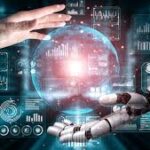Artificial Intelligence (AI) is a branch of computer science that aims to create machines or software that can perform tasks that typically require human intelligence. These tasks include learning, reasoning, problem-solving, perception, understanding natural language, and even creativity. AI works through a combination of algorithms, data processing, and advanced mathematical models. Below, we break down the key components of how AI works:
1. Data Collection and Input
AI systems require large amounts of data to function properly. This data can come from a variety of sources such as sensors, cameras, user interactions, or internet activity. The data is essential for training AI models, allowing them to learn patterns and make decisions.
- Structured Data: This includes data in a well-organized format, such as databases or spreadsheets (e.g., numbers, text, or dates).
- Unstructured Data: Data that is less organized, such as images, audio, and text documents, which may require preprocessing to be useful for AI systems.
2. Machine Learning (ML) and Algorithms
Machine Learning (ML) is a subset of AI that enables machines to learn from data and improve over time. In simple terms, ML algorithms allow AI systems to “learn” from examples rather than being explicitly programmed with specific rules.
- Supervised Learning: This is where the AI is trained on a labeled dataset, meaning the data includes both inputs and the correct outputs. For example, a supervised learning model might be trained to recognize images of cats by showing it many labeled images of cats (and non-cats) and the correct labels. The AI system learns to classify new, unseen images by finding patterns in the training data.
- Unsupervised Learning: In unsupervised learning, the AI system is given unlabeled data and must find hidden patterns or structures in it. For instance, clustering algorithms might group similar items together, such as categorizing customers based on their buying behavior.
- Reinforcement Learning: This type of learning is inspired by how humans learn from experience. In reinforcement learning, an AI system learns by interacting with an environment and receiving feedback in the form of rewards or penalties. Over time, the system learns to take actions that maximize the reward.
3. Neural Networks and Deep Learning
At the core of many AI systems today are neural networks, particularly deep learning models. These are inspired by the structure of the human brain and consist of layers of interconnected nodes (neurons).
- Neural Networks: A neural network consists of an input layer, hidden layers, and an output layer. Each node in a layer processes information and passes it to the next layer. As the information moves through these layers, the neural network adjusts the connections (weights) between nodes to minimize errors and make more accurate predictions.
- Deep Learning: Deep learning is a subfield of ML that uses large, deep neural networks (with many layers) to process data. It is particularly effective for tasks involving large volumes of unstructured data, such as image recognition, natural language processing (NLP), and speech recognition.
4. Natural Language Processing (NLP)
Natural Language Processing is an area of AI focused on the interaction between computers and human language. NLP enables AI systems to understand, interpret, and generate human language in a way that is valuable for tasks like translation, speech recognition, sentiment analysis, and chatbots.
- Tokenization: This involves breaking text into smaller parts, such as words or sentences, for easier analysis.
- Semantic Analysis: AI systems analyze the meaning of words and phrases within context to understand intent and meaning.
- Language Generation: Using language models, AI can generate human-like responses based on learned patterns and structures from a large dataset of text.
5. Computer Vision
Computer vision is a field within AI that enables machines to interpret and make sense of visual data (e.g., images, videos). AI systems use computer vision to recognize objects, detect faces, track movement, and analyze visual content.
- Convolutional Neural Networks (CNNs): These are deep learning models specifically designed for processing and analyzing images. CNNs can automatically detect features such as edges, textures, and shapes in an image, making them highly effective for tasks like image classification and object detection.
6. Decision Making and Problem Solving
Once an AI system has processed data and learned from it, it uses that knowledge to make decisions or solve problems. This process may involve:
- Rule-Based Systems: Some AI systems use predefined rules or expert knowledge to make decisions based on specific conditions. These are common in systems that require structured inputs and outputs, like customer support bots or recommendation systems.
- Probabilistic Models: In many cases, AI systems use probabilistic models to make decisions under uncertainty. These models, like Bayesian networks, use statistical methods to predict outcomes and optimize decision-making.
7. Optimization and Adaptation
AI systems constantly adapt and improve based on feedback and new data. This could mean:
- Fine-Tuning Models: Once trained, AI models are periodically updated with new data to maintain their relevance and accuracy. Fine-tuning is crucial to ensure the model performs well as conditions change over time.
- Continuous Learning: Some AI systems have the ability to continuously learn from new data and real-world interactions. For example, recommendation engines for streaming services improve over time by analyzing user preferences.
8. AI in Action: Practical Examples
To understand how AI works in practice, here are some real-world applications:
- Self-Driving Cars: These cars use AI, sensors, and machine learning algorithms to interpret data from their environment (e.g., cameras, radar, and lidar) to navigate safely and make decisions in real-time.
- Virtual Assistants: AI powers virtual assistants like Amazon’s Alexa, Google Assistant, and Apple’s Siri, which use speech recognition (NLP), contextual understanding, and machine learning to carry out tasks such as setting reminders, answering questions, and controlling smart devices.
- Recommendation Systems: AI-driven algorithms are behind the recommendation engines of platforms like Netflix, YouTube, and Amazon. These systems analyze users’ behaviors, preferences, and patterns to suggest content or products that are likely to interest them.
- Healthcare: AI is used in healthcare for diagnosing diseases, analyzing medical images, and developing personalized treatment plans. Deep learning models, for instance, can analyze X-rays or MRIs to identify conditions such as cancer or fractures.
Conclusion
AI works by leveraging data, algorithms, and machine learning techniques to enable machines to perform tasks that traditionally required human intelligence. From simple rule-based systems to sophisticated deep learning models, AI is constantly evolving to solve increasingly complex problems. The combination of data, learning, and decision-making models allows AI to continuously improve, making it a powerful tool in fields ranging from healthcare and entertainment to autonomous driving and customer service.




